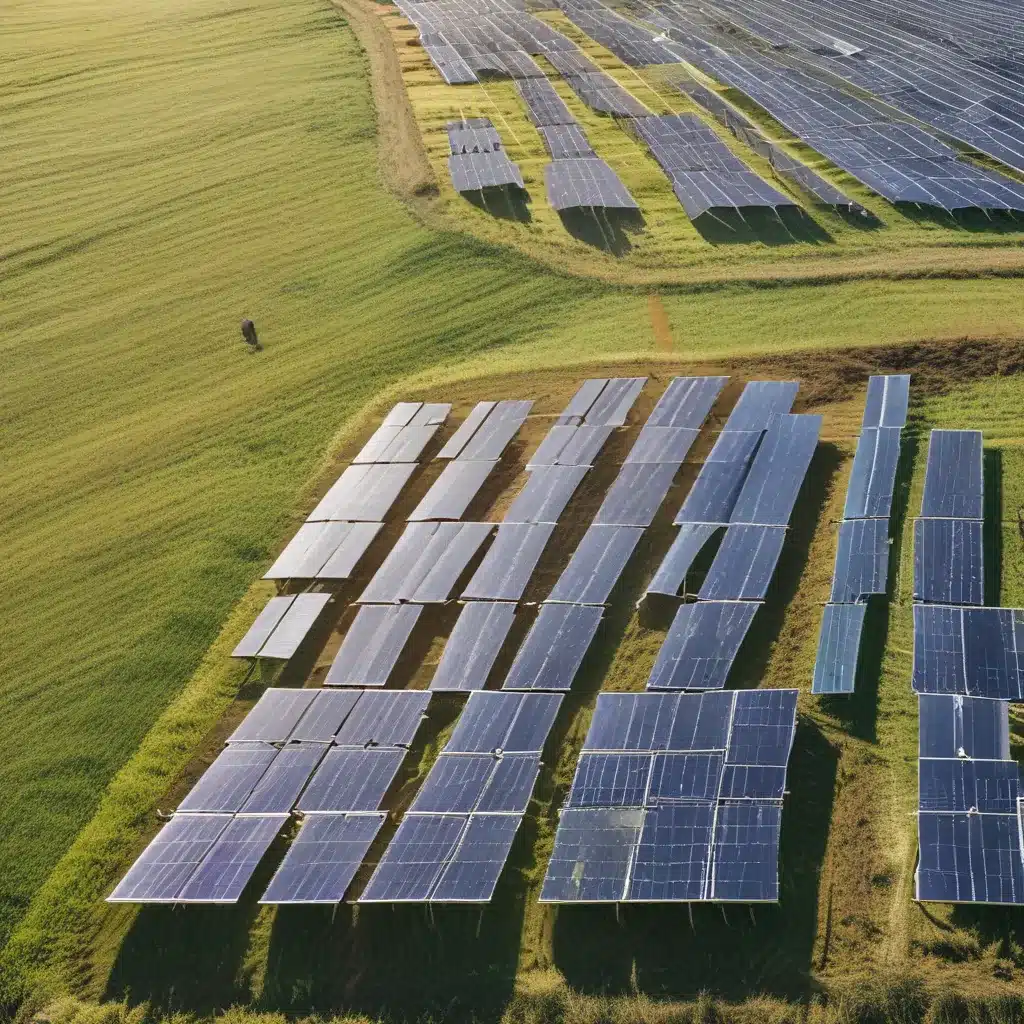
Imagine a world where sunshine isn’t just a source of warmth and light, but a powerful tool that can revolutionize the way we grow our food. That’s the intriguing promise of solar energy for farms and agriculture – a marriage of cutting-edge technology and time-honored traditions that’s poised to transform the way we think about sustainable farming.
As a solar energy enthusiast and someone who’s always looking for ways to combine my love of the great outdoors with innovative solutions, I’ve been following the rise of “agrivoltaics” with keen interest. This emerging field, which explores the co-location of solar photovoltaic (PV) systems and agricultural activities, has the potential to reshape the landscape of modern farming.
The Power of Co-Location
The concept behind agrivoltaics is deceptively simple: why not harness the same land for both solar energy generation and agricultural production? As it turns out, the two can actually work in harmony, providing benefits to both the solar and farming industries.
According to the U.S. Department of Energy, as of March 2023, there were 314 agrivoltaic projects in the United States, representing over 28 gigawatts of solar capacity. These projects have primarily focused on grazing and pollinator habitats, with relatively few integrating crop production. But the potential is enormous, as the same attributes that make land suitable for solar energy – abundant sunshine and flat terrain – are also highly desirable for agriculture.
The benefits of this co-location are manifold. Farmers can diversify their revenue streams by leasing land to solar developers, while also enjoying the ecological benefits of the solar panels, such as reduced water evaporation and improved microclimate conditions. Meanwhile, solar companies can reduce their “soft costs” – the non-hardware expenses associated with solar installation – by leveraging existing agricultural infrastructure and land use.
Designing for Dual Functionality
Of course, successfully integrating solar and agriculture requires a delicate balance and thoughtful design. The World Economic Forum notes that exploring alternate solar system designs and agricultural practices that optimize both energy and agricultural production is key to unlocking the full potential of agrivoltaics.
One such example is the work being done by researchers at the Agritecture organization. They’ve identified the world’s largest farm to grow crops under solar panels, demonstrating the viability of this approach and providing valuable insights for others looking to follow suit.
By carefully positioning the solar panels and selecting crops that thrive in the modified microclimate, these pioneering farmers have managed to produce bumper crops while also generating clean, renewable energy. It’s a true testament to the power of innovation and collaboration between the solar and agricultural sectors.
Overcoming Challenges
Of course, integrating solar and agriculture isn’t without its challenges. As the Department of Energy points out, solar energy is likely to conflict with agricultural land use, as the same attributes that make land suitable for solar also make it attractive for farming.
But the potential benefits are too significant to ignore. That’s why the Department of Energy’s Solar Energy Technologies Office (SETO) is actively funding research and development in the agrivoltaics space, with the goal of overcoming the barriers to widespread adoption.
From conducting impact studies to examine how agrivoltaic designs affect both agricultural production and energy output, to developing new system designs and technologies that can integrate seamlessly into existing solar farms, SETO is leading the charge in unlocking the full potential of this exciting field.
The Future of Farming and Solar
As we look to the future, the possibilities for solar energy and agriculture are truly limitless. Imagine a world where every farm is also a solar power plant, generating clean energy while simultaneously nurturing the crops and livestock that sustain us. It’s a vision that’s rapidly becoming a reality, thanks to the tireless efforts of researchers, entrepreneurs, and forward-thinking farmers.
And let’s not forget the broader implications of this revolution. By harnessing the power of the sun to power our agricultural systems, we can not only reduce our reliance on fossil fuels and mitigate the effects of climate change, but also enhance food security, support local economies, and create a more sustainable future for generations to come.
At Solar A Systems Inc., we’re thrilled to be a part of this exciting journey. As a leading provider of solar energy solutions, we’re committed to working closely with farmers and agricultural enterprises to explore the vast potential of agrivoltaics and unlock the full power of the sun.
So, whether you’re a farmer looking to diversify your income streams, a solar enthusiast eager to see the technology transform the world of agriculture, or simply someone who cares about the future of our planet, I invite you to join me in embracing the solar-powered revolution that’s about to sweep across our farms and fields.
The future of sustainable, climate-smart agriculture is here, and it’s as bright as the sun itself.


